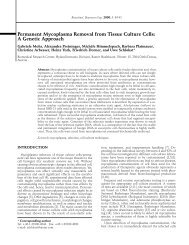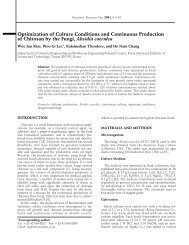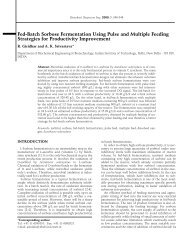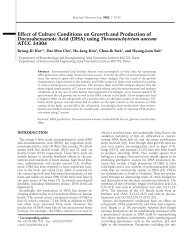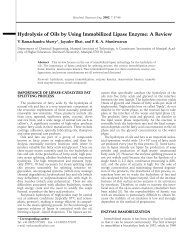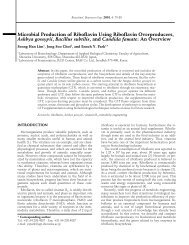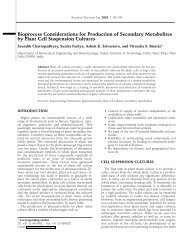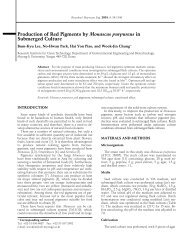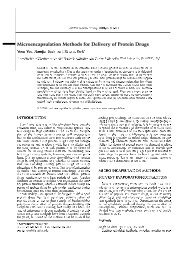Silicone Rubber Membrane Bioreactors for Bacterial Cellulose ...
Silicone Rubber Membrane Bioreactors for Bacterial Cellulose ...
Silicone Rubber Membrane Bioreactors for Bacterial Cellulose ...
Create successful ePaper yourself
Turn your PDF publications into a flip-book with our unique Google optimized e-Paper software.
Biotechnol. Bioprocess Eng. 2002, 7: 289-294<strong>Silicone</strong> <strong>Rubber</strong> <strong>Membrane</strong> <strong>Bioreactors</strong> <strong>for</strong> <strong>Bacterial</strong> <strong>Cellulose</strong>ProductionMasayuki Onodera 1 , Ikuro Harashima 1 , Kiyoshi Toda 1 *, and Tomoko Asakura 21 Department of Applied Chemistry and Biotechnology, Niigata Institute of Technology, 1719 Fujihashi, Kashiwazaki 945-1195,Japan2 Institute of Molecular and Cellular Biosciences, The University of Tokyo, 1-1-1 Yayoi, Bunkyo-ku, Tokyo 113, JapanAbstract <strong>Cellulose</strong> production by Acetobacter pasteurianus was investigated in static culture using fourbioreactors with silicone rubber membrane submerged in the medium. The shape of the membrane wasflat sheet, flat sack, tube and cylindrical balloon. Production rate of cellulose as well as its yield on consumedglucose by the bacteria grown on the flat type membranes was approximately ten-fold greater thanthose on the non-flat ones in spite of the same membrane thickness. The membrane reactor using flatsacks of silicone rubber membrane as support of bacterial pellicle can supply greater ratio of surface tovolume than a conventional liquid surface culture and is promising <strong>for</strong> industrial production of bacterialcellulose in large scale.Keywords: bacterial cellulose; surface culture; silicone rubber membrane; Acetobacter pasteurianusINTRODUCTION<strong>Bacterial</strong> cellulose (BC) attracts researchers' attentionbecause the fibril is superior to that found in plant cellulosein purity and its firm supra molecular structure [1]. Thetypical size of fibers of BC is 0.1 micrometer thick, which isabout one-hundredth that of wood fibers. Also the reticulatednetwork of the fine fibrils provides a wet BC pelliclewith a large surface area, high water retaining capacity,moldability, and a dried BC sheet, strong tear resistance [2].These properties of BC have been applied in the manufactureof high fidelity acoustic speakers [3], and high qualitypaper [4]. Attempts have been made to use it as artificialskin [5], ultrafiltration membrane [6], culture substrate <strong>for</strong>mammalian cells [7], cover-membrane <strong>for</strong> glucose biosensors[8], as well as binders <strong>for</strong> powders and thicke ners <strong>for</strong>paint, ink and adhesives [9].<strong>Bacterial</strong> cellulose production had been studied extensivelyfrom 1992 to 1998 in Japan [10]. Among them somebiochemical engineering studies on cellulose productionwere done using aeration and agitation culture [11], andairlift fermentor [12] Although most of fermentative productionby aerobic microorganisms were per<strong>for</strong>med in theagitated and/or aerated reactor, Nata (a cellulosic foodproduct) is produced in industrial scale by liquid surfaceculture. This is because most of the cellulose-producingbacteria are unstable in their ability in agitated or bubbledculture. For large-scale fermentation in static culture, largearea of air-liquid interface is necessary. If we can preparestatic air-liquid surfaces in* Corresponding authorTel: +81-0257-22-8136 Fax: +81-0257-22-8136e-mail: toda@acb.niit.ac.jpthe medium of a fermentor, static cellulose production willimprove greatly. There are many kinds of oxygenpermeablemembrane of synthetic as well as natural substances.Some of the membranes may be used as a substituteof air-liquid interface.In our previous paper we reported that BC was producedon some oxygen permeable me mbranes, each of which wasput into the bottom of a static culture vessel [13]. Amongthe membranes tested, silicone rubber sheet was best <strong>for</strong>developing the cellulose pellicle. We found in another studythat a bioreactor with a bundle of silicone tubes submergedin the culture liquid could provide high oxygen absorptionrate, and was suitable <strong>for</strong> oxidation of ethanol to acetic acidby acetic acid bacteria [14]. In the present study we usedsilicone tubes as a support of BC pellicle in a bioreactorexpecting they might provide larger membrane-liquidinterfacial area than a bottom silicone rubber sheet.However BC production on outer surface of silicone tubeswas much less than that of flat membranes. Using someother silicone rubber membranes of different geometrical<strong>for</strong>m and size, we investigated the effect of me mbranemorphology on BC production to look <strong>for</strong> optimum shapeof silicone rubber membrane in practical bacterial celluloseproduction.MATERIALS AND METHODS<strong>Bacterial</strong> Strains and Culture MediumAcetobacter pasteurianus AP and APSK, and Acetobacterxylinum DA were used. A. pasteurianus AP was isolated asa single colony from the supernatant of a static liquid cultureof Acetobacter pasteurianus ATCC 10245. Strain
290 Biotechnol. Bioprocess Eng. 2002, Vol. 7, No. 5Fig. 1. Culture vessels <strong>for</strong> growing cellulose-producing bacteria onsurface of silicone rubber membrane. Shape of silicone rubbermembranes is Flat sheet (A), Tube (B), Cylindrical balloon (C),and Flat sack (D). For the details see the text.APSK was a mutant resistant to kanamycin (30 mg/dm 3 ) andstreptomycin (10 mg/dm 3 ) of A. pasteurianus AP [13]. Acetobacterxylinum DA was an acetic acid-resistant strain isolatedfrom a continuous surface culture <strong>for</strong> acetic acid production[15]. The composition of the medium [16], consisted(per liter) of 5 g yeast extract (Difco, Detroit, USA), 5g Polypepton (Nihon Seiyaku, Tokyo, Japan), 2.7 gNa 2 HPO 4 , 1.15 g citric acid mono-hydrate and 20 g glucose(pH 6.0). Aspergillus oryzae IAM2958 was used in a referenceexperiment.CultureFig. 1 shows the schematic illustration of the culture vesselsused to grow the cellulose-producing bacteria on thesurface of silicone rubber membrane. Four types of siliconerubber membranes were used: flat sheet (A), tube (B),cylindrical-balloon(C), and flat-sack (D).The vessel A in Fig. 1 has a flat sheet of silicone rubbermembrane (40 mm diameter, 0.5 mm thickness) at the bottomof a polypropylene cup (60 mm top diameter, 50 mmbottom diameter, 27 mm height). The down side of theme mbrane was exposed to the atmosphere. The medium of0.026 dm 3 was put in the vessel and the liquid surface wascovered with another cup of the same size. The vessel Bis a test tube (26 mm od, 200 mm height) in which fourpieces of silicone tube (3.2 mm od, 2.2 mm id, 105 mm long,0.5 mm thickness) were inserted through a rubber plug asshown in Fig. 1(B). The medium volume was 0.073 dm 3 .Air was passed through the tubes at a flow rate of 0.2dm 3 /min. The vessel C is a glass cylinder (50 mm id, 250mm height) with rubber plugs at the ends. A tubular siliconerubber membrane (32 mm od, 170 mm long, 0.15 mmthickness) with rubber plugs at the ends was submerged intothe medium (0.15 dm 3 ) in the glass cylinder. By flowing airthrough the tubular membrane at a flow rate of 0.2 dm 3 /min,it inflated like a long balloon as shown in Fig. 1(C). At anairflow rate less than 0.2 dm 3 / min, it deflated and flattened.The medium volume was increased to 0.3 dm3 <strong>for</strong> maintainingthe appropriate contact between the membrane and themedium. The vessel D is a glass beaker (2.4 dm 3 mediumvolume). A tubular silicone rubber membrane (0.14 mmthickness) was spun on a U-wire (130 mm long width, 42mm short width, 8 mm wire diameter) to make a flat sack.The sack was submerged in the medium. The air was flowedthrough the sack as shown in Fig. 1(D).The membranes were supplied from Nagayanagi Co.(Tokyo, Japan). The thickness of the membranes was 0.5mm (A and B) and 0.14-0.15 mm(C and D). A supernatantof the liquid surface culture incubated <strong>for</strong> 7 d at 30 o C using0.03 dm 3 medium in a 0.1 dm 3 conical flask was inoculatedinto each culture vessel at a ratio of 5 v/v%. All the cultureexperiments were carried out at 30 o C <strong>for</strong> 7days (exceptmentioned otherwise) under static conditions.Measurement of <strong>Cellulose</strong> ProductionThe cellulose pellicle of Acetobacter pasteurianus grownon liquid or membrane surfaces was harvested and treatedwith 1 N NaOH <strong>for</strong> 1 day at room temperature to disrupt thecells in the pellicle. It was then washed with running tapwater <strong>for</strong> 1 day. <strong>Cellulose</strong> in the pellicle was measured asdry-weight after drying at 105 o C to a constant weight.Assay of Glucose and Gluconic AcidThe glucose concentration of the culture supernatant wasmeasured colorimetrically by the Glucostat method usingglucose oxidase, peroxidase, and o-dianisidine. Gluconicacid was assayed using a gluconic acid analysis kit (BoehringerMannheim GmbH, Mannheim, Germany).Electron MicroscopyMicroscopic structure of bacterial pellicle was observedwith a scanning electron microscope (JSM-5200 LV, Tokyo,Japan). Dehydrated bacterial pellicle was prepared by rinsinga small piece (1 × 1 × 0.3 cm) of intact bacterial pelliclewith flowing tap water and soaking into 0.1 dm 3 of 99.5v/v% ethanol <strong>for</strong> a few weeks and then drying at room temperature<strong>for</strong> two days on a filter paper No. 5A (Toyoroshi,Tokyo, Japan).
Biotechnol. Bioprocess Eng. 2002, Vol. 7, No. 5 291Fig. 2. <strong>Cellulose</strong> production on surfaces of silicone tube (blackbar) and silicone rubber sheet (shaded bar). AP, APSK and DAdenote Acetobacter pasteurianus ATCC 10245, a mutant of APresistant to streptomycin and kanamycin, and Acetobacter xylinumDA, respectively.RESULTS AND DISCUSSION<strong>Bacterial</strong> <strong>Cellulose</strong> Production on Tubes VersusFlat Sheet of <strong>Silicone</strong> <strong>Rubber</strong>The two strains of Acetobacter pasteurianus (AP andAPSK) and A strain of Acetobacter xylinum (DA) was culturedstatically <strong>for</strong> one week using the vessels A and Bshown in Fig. 1. The amount of cellulose produced on a flatsilicone rubber sheet (Fig. 1(A)) and silicone tubes (Fig.1(B)) of the same thickness (0.5 mm) was determined. Theresult shown in Fig. 2, estimates superficial cellulose productionrate as the amount (g) of cellulose produced per unitsurface area (m 2 ) per day. The rate on silicone tubes was aslow as one-tenth that on a flat silicone rubber sheet, althoughculture conditions were the same. This tendency wasobserved <strong>for</strong> each of the three bacterial strains, AP, APSKand DA. Only strain APSK was used in the following experiments,as its cellulose production was relatively stableand better.Fig. 3 shows the time course of static cultures of Acetobacterpasteurianus APSK using silicone tubes and a flatsilicone rubber membrane as the support <strong>for</strong> the cellulosepellicle. The time -dependent curves <strong>for</strong> remaining glucose,concentration of gluconic acid produced from glucose, andculture pH were almost the same in both cultures. Neverthelessthe superficial cel-lulose production rate differed remarkablybetween the two cultures. As stated previously,the rate <strong>for</strong> the static culture using silicone tubes was aboutone-tenth lower than that using a flat silicone rubber me m-brane. Con-sequently, the cellulose yield was very small(0.023 g on g-glucose consumed) in the culture using siliconetubes in comparison with a flat silicone rubber sheet(0.193 g g -1 ), although the membrane surface area in unitvolume of the culture liquid was almost the same in bothcultures.In an attempt to elucidate the difference in cellulose productionon flat and tubular silicone rubber me mbrane,Fig. 3. Time course of static liquid cultures of A. pasteurianusAPSK on silicone rubber sheet (open symbols) and silicone tubes(closed symbols). Measurements were done with cellulose (diamonds),glucose (circles), gluconic acid (triangles), and pH(squares).we calculated effectiveness factor of oxygen diffusion in thegrowing cellulose pellicle on each surface by a model simulation.The model includes the partial differential equationsof concentration distribution <strong>for</strong> oxygen and substrate incylindrical coordinates. The reaction term <strong>for</strong> oxygen consumptionwas assumed as Monod kinetics concerning bothoxygen and substrate.Effectiveness factors <strong>for</strong> the pellicles of 2 mm thicknesson the tubes of 2 and 4 mm outer diameters were estimatedas 0.49 and 0.65 respectively while it was unity <strong>for</strong> that on aflat membrane. This estimation is consistent with the resultof an experiment (data not shown) in which mycelialgrowth rate of Aspergillus oryzae IAM 2958 was half on asilicone tube (3.2 mm outer diameter) than on a liquid surface.However we cannot relate the difference (1/2 to 2/3) inthe calculated effectiveness factors with the larger difference(about one-tenth) in the superficial cellulose productionrates between on a silicone tube and on a flat siliconerubber membrane (Fig. 2). Why flat surface is superior tonon-flat one concerning bacterial cellulose production is left<strong>for</strong> further investigation.Effect of Tube Size and Surface Processing of<strong>Silicone</strong> Tube on <strong>Cellulose</strong> Production RateWe observed that tube type membrane was inferior tosheet type as a support <strong>for</strong> cellulose production. How-
292 Biotechnol. Bioprocess Eng. 2002, Vol. 7, No. 5(g m -2 day -1 )Fig. 5. <strong>Cellulose</strong> production of A. pasteurianus APSK on siliconerubber membrane of flat sheet, flat sack and cylindrical balloon.on the intact tube surface was not. However superficial celluloseproduction rate was not affected by the processing ofthe tube surface.Electromicrograph of <strong>Cellulose</strong> PelliclesFig. 4. Electromicrograph of bacterial pellicle grown on flat (B)and tubular (A) silicone rubber membranes.ever silicone tube is considerably suitable <strong>for</strong> supplyingoxygen by flowing air through its inner space and easy tohandle. We examined the possibility of using silicone tube<strong>for</strong> static cellulose production further.<strong>Silicone</strong> tube of 3.2 mm outer diameter was used in mostof the experiment. Larger and smaller tubes were used toinvestigate the effect of tube size on cellulose production:outer diameter of 0.8 to 4.0 mm with constant thickness of0.25 mm. The tube size did not affect superficial celluloseproduction rate in the range tested (data not shown).<strong>Bacterial</strong> cellulose pellicle grew radially on a tube surfacethat differed from unidirectional growth on a flat surface.This might be one of the factors deteriorating cellulose productionon a tube surface. More energy is required <strong>for</strong> abacterial pellicle to develop in radial direction because thecellulose fibrils in the pellicle must expand against the firmtensile strength of the circular network of cellulose fibrils.We attached a neoprene rectangular bar (1 mm × 2 mm, 105mm long) or a silicone tube (2 mm od, 1 mm id, 105 mmlong) along the outer surface of the silicone tube (4.0 mmod, 3.5 mm id) to reduce the geometrical restriction againstbacterial growth on a tube surface. The cellulose pelliclegrown on the surface was easily peeled off while thatWe peeled cellulose pellicles from both the surfaces oftubular and flat silicone rubber membranes, and dehydratedthem. Microphotographs of the dry pellicles are shown inFig. 4. With the cellulose pellicle developed on a flat me m-brane cellulose, microfibrils were hardly observed probablydue to close assembly of cellulose microfibrils (Fig. 4(B)).In contrast, the loose networks of cellulose fibrils were observedin the pellicle developed on a tubular surface (Fig.4(A)).<strong>Cellulose</strong> Production on Cylindrical Balloon andFlat Sack of <strong>Silicone</strong> <strong>Rubber</strong> <strong>Membrane</strong>In the previous experiment, we used silicone tubes of 0.8to 4.0 mm in outer diameter to investigate how tube curvatureaffects bacterial cellulose production. There was nosignificant difference in cellulose production rate among thetubes. The rate was much lower than that on a flat me m-brane. To examine whether the tube diameter affects celluloseproduction rate, a silicone rubber cylinder of 30 mm indiameter and 0.15 mm in thickness was used to support thecellulose pellicle in the following experiment. The cylinderwas immersed into a liquid medium after closing the endswith neoprene plugs (Fig. 1(C)). By flowing air through thecylinder at a flow rate of 0.95 dm 3 /min, it inflated like along balloon in the liquid. At a lower air flow rate (0.5dm 3 /min), the balloon deflated and partly wrinkled. We usedanother shape of silicone rubber membrane: a flat siliconerubber sack (Fig. 1(D)) that was made by covering a U-wire with silicone rubber cylinder and closing
Biotechnol. Bioprocess Eng. 2002, Vol. 7, No. 5 293Table 1. Effect of membrane expansion on cellulose production bybacteria grown on flat sack (Fig. 1(D))<strong>Membrane</strong>expansion (%)
294 Biotechnol. Bioprocess Eng. 2002, Vol. 7, No. 5[7] Watanabe, K., Y. Eto, S. Takano, S. Nakamori, H. Shibai, andS. Yoshinaka (1993) A new bacterial cellulose substrate <strong>for</strong>mammalian cell culture. Cytotechnol. 13: 107-114.[8] Ammon, H. P. T., W. Ege, M. Oppenmann, W. Goepel, and S.Eisele (1995) Improvement in the long-term stability of anamperometric glucose sensor system by introducing a cellulosemembrane of bacterial origin. Anal. Chem. 67: 66-471.[9] Cannon, E. and S. M. Anderson (1991) Biogenesis of bacterialcellulose. Crit. Rev. Microbiol. 17: 435-447.[10] Yoshinaga, F. , N. Tonouchi, and K. Watanabe (1997) Researchprogress in production of bacterial cellulose by aerationagitation culture and its application as a new industrialmaterial. Biosci. Biotech. Biochem. 61: 219-224.[11] Kouda, T., Y. Hisato, and F. Yoshinaga (1997) Effect of agitatorconfiguration on bacterial cellulose productivity in aeratedand agitated culture. J. Ferment. Bioeng. 83: 371-376.[12] Chao Y. -P, Y. Sugano, T. Kouda, F. Yoshinaga, and M. Shoda(1997) Production of bacterial cellulose by Acetobacter xylinumwith an airlift reactor. Biotechnol. Tech. 11: 829-832.[13] Yoshino T., T. Asakura, and K. Toda (1996) <strong>Cellulose</strong> productionby Acetobacter pasteurianus on silicone membrane.J. Ferment. Bioeng. 81: 32-36.[14] Toda K. and T. Asakura (1997) <strong>Cellulose</strong> production by aceticacid -resistant Acetobacter xylinum. J. Ferment. Bioeng.84: 228-231.[15] Toda K. and T. Asakura (1994) Acetic acid production byAcetobacter aceti in a silicone tube bioreactor. Biotechnol.Lett. 16: 617-620.[16] Schramm, M. and S. Hestrin (1954) Synthesis of cellulose byAcetobacter xylinum: 1. Micromethod <strong>for</strong> the determinationof celluloses. Biochem. J. 56: 163-166.[17] Ross, P., H. Weinhouse, Y. Aloni, D. Michaeli, P. Ohama, R.Mayer, S. Braun, E. de Vroom, G. A. van der Marel, J. H. vanBoom, and M. Benzimann (1987) Regulation of cellulosesynthesis in Acetobacter xylinum by cyclic diguanyllic acid.Nature 325: 279-281.[18] Zaar, K. (1979) Visualization of pores (export sites) correlatedwith cellulose production in the envelope of the Gramnegativebacterium Acetobacter xylinum. J. Cell. Biol. 80:773-777.[Received April 2, 2002; accepted August 9, 2002]




